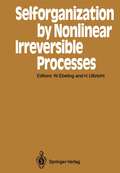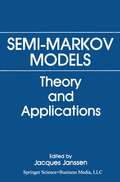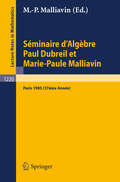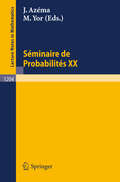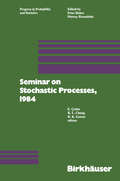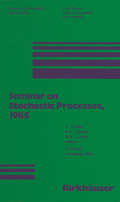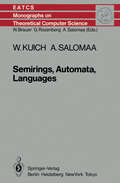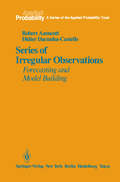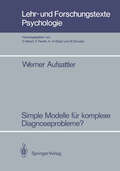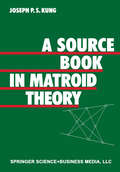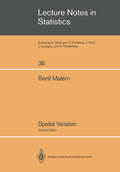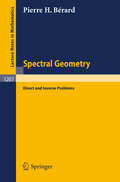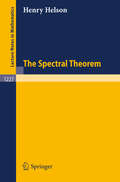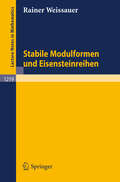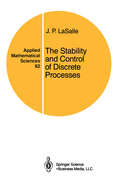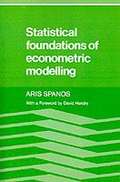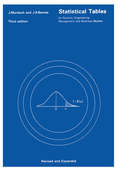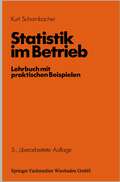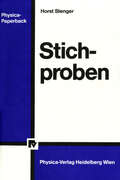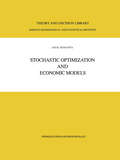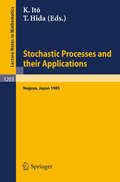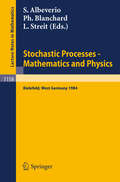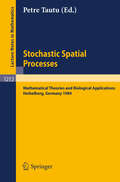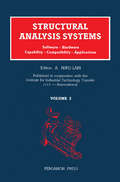- Table View
- List View
Selforganization by Nonlinear Irreversible Processes: Proceedings of the Third International Conference Kühlungsborn, GDR, March 18–22, 1985 (Springer Series in Synergetics #33)
by Werner Ebeling Heinz UlbrichtSemi-Markov Models: Theory and Applications
by Jacques JanssenThis book is the result of the International Symposium on Semi Markov Processes and their Applications held on June 4-7, 1984 at the Universite Libre de Bruxelles with the help of the FNRS (Fonds National de la Recherche Scientifique, Belgium), the Ministere de l'Education Nationale (Belgium) and the Bernoulli Society for Mathe matical Statistics and Probability. This international meeting was planned to make a state of the art for the area of semi-Markov theory and its applications, to bring together researchers in this field and to create a platform for open and thorough discussion. Main themes of the Symposium are the first ten sections of this book. The last section presented here gives an exhaustive biblio graphy on semi-Markov processes for the last ten years. Papers selected for this book are all invited papers and in addition some contributed papers retained after strong refereeing. Sections are I. Markov additive processes and regenerative systems II. Semi-Markov decision processes III. Algorithmic and computer-oriented approach IV. Semi-Markov models in economy and insurance V. Semi-Markov processes and reliability theory VI. Simulation and statistics for semi-Markov processes VII. Semi-Markov processes and queueing theory VIII. Branching IX. Applications in medicine X. Applications in other fields v PREFACE XI. A second bibliography on semi-Markov processes It is interesting to quote that sections IV to X represent a good sample of the main applications of semi-Markov processes i. e.
Séminaire d'Algèbre Paul Dubreil et Marie-Paul Malliavin: Proceedings Paris 1985 (37ème Année) (Lecture Notes in Mathematics #1220)
by Marie-Paule MalliavinSéminaire de Probabilités XX 1984/85: Proceedings (Lecture Notes in Mathematics #1204)
by Jacques Azema Marc YorSeminar on Stochastic Processes, 1984 (Progress in Probability #9)
by Cinlar Chung GetoorThis volume consists of about half of the papers presented during a three-day seminar on stochastic processes held at Northwestern U- versity, Evanston. The seminar was the fourth of such yearly seminars aimed at bringing together a small group of researchers to discuss their current work in an informal atmosphere. The invited participants in the seminar were B.W. ATKINSON, R.M. BLUMENTHAL, K. BURDZY, D. BURKHOLDER, M. CRANSTON, C. DOLEANS"'DADE, J.L. DOOB, N. FALKNER, P. FITZSIMMONS, J. GLOVER, F. KNIGHT, T. McCONNELL, J.B. MITRO, S. OREY, J. PITMAN, A.O. PITTENGER, Z. POP- STOJANOVIC, P. PROTTER, T. SALISBURY, M. SHARPE, C.T. SHIH, A. SZNITMAN, S.J. TAYLOR, J. WALSH, and R. WILLIAMS. We thank them and the other partiCipants for the lively seminar they created. The seminar was made possible through the partial support of the Air Force Office of Scientific Research via their Grant No. 82-0109 to Northwestern University. E.
Seminar on Stochastic Processes, 1985 (Progress in Probability #12)
by CINLAR CHUNG GETOORThe 1985 Seminar on Stochastic Processes was held at the University of Florida, Gainesville, in March. It was the fifth seminar in a continuing series of meetings which provide opportunities for researchers to discuss current work in stochastic processes in an informal atmosphere. Previous seminars were held at Northwestern University, Evanston and the University of Florida, Gainesville. The participants' enthusiasm and interest have resulted in stimulating and successful seminars. We thank them for it, and we also thank those participants who have permitted us to publish their research here. The seminar was made possible through the generous supports of the Division of Sponsored Research and the Department of Mathematics of the university of Florida, and the Air Force Office of Scientific Research, Grant No. 82- 0189. We are grateful for their support. Finally, the comfort and hospitality we enjoyed in Gainesville were due to the splendid efforts of Professor Zoran Pop-Stojanovic. J. G.
Semirings, Automata, Languages (Monographs in Theoretical Computer Science. An EATCS Series #5)
by W. Kuich A. SalomaaAutomata theory is the oldest among the disciplines constituting the subject matter of this Monograph Series: theoretical computer science. Indeed, automata theory and the closely related theory of formal languages form nowadays such a highly developed and diversified body of knowledge that even an exposition of "reasonably important" results is not possible within one volume. The purpose of this book is to develop the theory of automata and formal languages, starting from ideas based on linear algebra. By what was said above, it should be obvious that we do not intend to be encyclopedic. However, this book contains the basics of regular and context-free languages (including some new results), as well as a rather complete theory of pushdown automata and variations (e. g. counter automata). The wellknown AFL theory is extended to power series ("AFP theory"). Additional new results include, for instance, a grammatical characterization of the cones and the principal cones of context-free languages, as well as new decidability results.
Series of Irregular Observations: Forecasting and Model Building (Applied Probability #2)
by Robert Azencott Didier Dacunha-CastelleAt the university level, in probability and statistics departments or electrical engineering departments, this book contains enough material for a graduate course, or even for an upper-level undergraduate course if the asymptotic studies are reduced to a minimum. The prerequisites for most of the chapters (l - 12) are fairly limited: the elements of Hilbert space theory, and the basics of axiomatic probability theory including L 2-spaces, the notions of distributions, random variables and bounded measures. The standards of precision, conciseness, and mathematical rigour which we have maintained in this text are in clearcut contrast with the majority of similar texts on the subject. The main advantage of this choice should be a considerable gain of time for the noninitiated reader, provided he or she has a taste for mathematical language. On the other hand, being fully aware of the usefulness of ARMA models for applications, we present carefully and in full detail the essential algorithms for practical modelling and identification of ARMA processes. The experience gained from several graduate courses on these themes (Universities of Paris-Sud and of Paris-7) has shown that the mathematical material included here is sufficient to build reasonable computer programs of data analysis by ARMA modelling. To facilitate the reading, we have inserted a bibliographical guide at the end of each chapter and, indicated by stars (* ... *), a few intricate mathematical points which may be skipped over by nonspecialists.
Series of Irregular Observations: Forecasting and Model Building (Applied Probability #2)
by Robert Azencott Didier Dacunha-CastelleAt the university level, in probability and statistics departments or electrical engineering departments, this book contains enough material for a graduate course, or even for an upper-level undergraduate course if the asymptotic studies are reduced to a minimum. The prerequisites for most of the chapters (l - 12) are fairly limited: the elements of Hilbert space theory, and the basics of axiomatic probability theory including L 2-spaces, the notions of distributions, random variables and bounded measures. The standards of precision, conciseness, and mathematical rigour which we have maintained in this text are in clearcut contrast with the majority of similar texts on the subject. The main advantage of this choice should be a considerable gain of time for the noninitiated reader, provided he or she has a taste for mathematical language. On the other hand, being fully aware of the usefulness of ARMA models for applications, we present carefully and in full detail the essential algorithms for practical modelling and identification of ARMA processes. The experience gained from several graduate courses on these themes (Universities of Paris-Sud and of Paris-7) has shown that the mathematical material included here is sufficient to build reasonable computer programs of data analysis by ARMA modelling. To facilitate the reading, we have inserted a bibliographical guide at the end of each chapter and, indicated by stars (* ... *), a few intricate mathematical points which may be skipped over by nonspecialists.
Simple Modelle für komplexe Diagnoseprobleme?: Zur Robustheit probabilistischer Diagnoseverfahren gegenüber vereinfachenden Modellannahmen (Lehr- und Forschungstexte Psychologie #21)
by Werner AufsattlerA Source Book in Matroid Theory
by KUNGby Gian-Carlo Rota The subjects of mathematics, like the subjects of mankind, have finite lifespans, which the historian will record as he freezes history at one instant of time. There are the old subjects, loaded with distinctions and honors. As their problems are solved away and the applications reaped by engineers and other moneymen, ponderous treatises gather dust in library basements, awaiting the day when a generation as yet unborn will rediscover the lost paradise in awe. Then there are the middle-aged subjects. You can tell which they are by roaming the halls of Ivy League universities or the Institute for Advanced Studies. Their high priests haughtily refuse fabulous offers from eager provin cial universities while receiving special permission from the President of France to lecture in English at the College de France. Little do they know that the load of technicalities is already critical, about to crack and submerge their theorems in the dust of oblivion that once enveloped the dinosaurs. Finally, there are the young subjects-combinatorics, for instance. Wild eyed individuals gingerly pick from a mountain of intractable problems, chil dishly babbling the first words of what will soon be a new language. Child hood will end with the first Seminaire Bourbaki. It could be impossible to find a more fitting example than matroid theory of a subject now in its infancy. The telltale signs, for an unfailing diagnosis, are the abundance of deep theorems, going together with a paucity of theories.
Spatial Variation (Lecture Notes in Statistics #36)
by B. MaternThis book was first published in 1960 as No. 5 of Volume 49 of Reports of the Forest Research Institute of Sweden. It was at the same time a doctor's thesis in mathematical statistics at Stockholm University. In the second edition, a number of misprints and other errors have been corrected. An author index and a subject index have been added. Finally, a new postscript comments on the later development of the subjects treated in the book. BERTIL MATERN March r¢6 Acknowledgements The completion of this thesis was facilitated through the generous assist ance of several persons and institutions. I would wish to express my sincere gratitude to my teacher, Professor HARALD CRAMtR, now chancellor of the Swedish universities, for his valuable help and encouragement. Sincere thanks are also offered to Professor ULF GRENANDER for kindly reading the first version of the manuscript and giving valuable advice. The thesis has been prepared during two widely separated periods. A preliminary draft of Ch. 2 was written in 1948, whereas the remaining parts were completed in 1959-1960. The work originates from problems which I discussed in a publication in 1947. The problems were assigned to me by Professor MANFRED NASLUND, former head of the Swedish Forest Research Institute, now governor of the province Norrbotten. It is a pleasure to acknowledge my gratefulness to Professor Naslund for his un remitting encouragement and interest in my work.
Spectral Geometry: Direct and Inverse Problems (Lecture Notes in Mathematics #1207)
by Pierre H. BerardThe Stability and Control of Discrete Processes (Applied Mathematical Sciences #62)
by J.P. LaSalleProfessor J. P. LaSalle died on July 7, 1983 at the age of 67. The present book is being published posthumously with the careful assistance of Kenneth Meyer, one of the students of Professor LaSalle. It is appropriate that the last publi cation of Professor LaSalle should be on a subject which con tains many interesting ideas, is very useful in applications and can be understood at an undergraduate level. In addition to making many significant contributions at the research level to differential equations and control theory, he was an excel lent teacher and had the ability to make sophisticated con cepts appear to be very elementary. Two examples of this are his books with N. Hasser and J. Sullivan on analysis published by Ginn and Co. , 1949 and 1964, and the book with S. Lefschetz on stability by Liapunov's second method published by Academic Press, 1961. Thus, it is very fitting that the present volume could be completed. Jack K. Hale Kenneth R. Meyer TABLE OF CONTENTS page 1. Introduction 1 2. Liapunov's direct method 7 3. Linear systems Xl = Ax. 13 4. An algorithm for computing An. 19 5. Acharacterization of stable matrices. Computational criteria. 24 6. Liapunovls characterization of stable matrices. A Liapunov function for Xl = Ax. 32 7. Stability by the linear approximation. 38 8. The general solution of Xl = Ax. The Jordan Canonical Form. 40 9. Higher order equations. The general solution of ~(z)y = O.
Statistical Foundations Of Econometric Modelling (PDF)
by Aris Spanos David HendryThis textbook provides an introduction to econometrics through a grounding in probability theory and statistical inference. The emphasis is on the concepts and ideas underlying probability theory and statistical inference, and on motivating the learning of them both at a formal and an intuitive level. It encourages the mastering of fundamental concepts and theoretical perspectives which guide the formulation and solution of problems in econometric modelling. This makes it an ideal introduction to empirical econometric modelling and the more advanced econometric literature. It is recommended for use on courses giving students a thorough grounding in econometrics at undergraduate or graduate level.
Statistical Tables: for Science, Engineering, Management and Business Studies
by J Murdoch J A BarnesWithin the third edition, the number of tables has been extended from 35 to 41, and several other features have been added, including worked examples of all the new tables (6) and useful formulae. New tables have been included on the basis that they are less commonly available and yet have been found to be useful in practcal work; they include Tukey's Wholly Significant Difference and a new section on Non-Parametric Tables. An American version of Control Chart limits has also been included for the US market. Worked examples of the use of new tables have been included at the end of the book.
Stochastic Optimization and Economic Models (Theory and Decision Library B #2)
by Jati SenguptaThis book presents the main applied aspects of stochas tic optimization in economic models. Stochastic processes and control theory are used under optimization to illustrate the various economic implications of optimal decision rules. Unlike econometrics which deals with estimation, this book emphasizes the decision-theoretic basis of uncertainty specified by the stochastic point of view. Methods of ap plied stochastic control using stochastic processes have now reached an exciti~g phase, where several disciplines like systems engineering, operations research and natural reso- ces interact along with the conventional fields such as mathematical economics, finance and control systems. Our objective is to present a critical overview of this broad terrain from a multidisciplinary viewpoint. In this attempt we have at times stressed viewpoints other than the purely economic one. We believe that the economist would find it most profitable to learn from the other disciplines where stochastic optimization has been successfully applied. It is in this spirit that we have discussed in some detail the following major areas: A. Portfolio models in ·:finance, B. Differential games under uncertainty, c. Self-tuning regulators, D. Models of renewable resources under uncertainty, and ix x PREFACE E. Nonparametric methods of efficiency measurement. Stochastic processes are now increasingly used in economic models to understand the various adaptive behavior implicit in the formulation of expectation and its application in decision rules which are optimum in some sense.
Stochastic Processes and Their Applications: Proceedings of the International Conference held in Nagoya, July 2-6, 1985 (Lecture Notes in Mathematics #1203)
by Kiyosi Ito Takeyuki HidaStochastic Processes - Mathematics and Physics: Proceedings of the 1st BiBoS-Symposium held in Bielefeld, West Germany, September 10-15, 1984 (Lecture Notes in Mathematics #1158)
by Sergio Albeverio Phillippe Blanchard Ludwig StreitStochastic Spatial Processes: Mathematical Theories and Biological Applications (Lecture Notes in Mathematics #1212)
by Petre TautuProceedings of a Conference held in Heidelberg, September 10 - 14, 1984
Structural Analysis Systems: Software — Hardware Capability — Compatibility — Applications
by A. Niku-LariStructural Analysis Systems: Software—Hardware Capability—Compatibility—Applications, Volume 2 is a practical guidebook on structural analysis systems and their applications. It provides detailed information about a specific software, its postprocessor capabilities and limitations, computer-aided design connection, and compatibility with the most common computers. Several practical examples from industry with computer and user cost are given. This volume consists of 17 chapters and begins with a description of AFAG, a dual finite element analysis program based on the flexibility method. The discussion then turns to the AQUADYN system, designed primarily to reduce the hydrodynamics problem to a linear integral equation for large floating or immersed structures. The following chapters focus on other structural analysis computer programs such as BOSOR4 and BOSOR5, INFESA, MEF/MOSAIC, RCAFAG, and STRUGEN. Some general purpose and special purpose finite element programs used for stress analysis of composite materials are also considered. This book will be a useful resource for practitioners in scientific and industrial disciplines such as mechanical or civil engineering, informatics, applied mathematics, and computer science.
